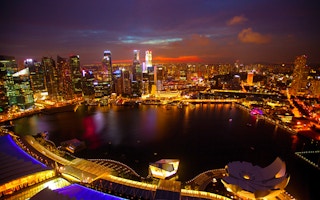Light-emitting diodes — smaller, more energy efficient and with lifespans of more than 20 years — are forcing market leaders Royal Philips NV and Osram Licht AG to adapt. The companies now seek long-term contracts to install complex lighting systems for whole cities from Washington DC to Amsterdam and equip buildings such as Paris’ Notre Dame cathedral with luminaires.
Washington’s transit authority in November awarded Philips, which has been selling light bulbs since 1891, a contract to upgrade 13,000 lighting fixtures in parking plots, along with a 10-year maintenance deal.
It gives the world’s biggest lighting maker a long-term income stream, and allows Washington to cut energy usage by 68 per cent.
“The budgets of cities and local communities are getting smaller and smaller and the pressure to be more efficient with budgets is increasing,” Florian Wunderlich, a Munich-based director at consultancy McKinsey & Co Inc, said in a phone interview. “So there’s a trend toward out-sourcing of non-core items such as lighting.”
So-called solid state lighting, which includes LEDs, infra-red and laser-based products, will account for two-thirds of the global lighting market by 2020, compared with 18 per cent in 2011, according to estimates from Munich-based Osram, the world’s second-biggest lighting maker.
Replacement rates
As replacement rates decline, Osram and Amsterdam-based Philips are seeking to stabilise revenue with multi-year contracts. Key to the new business model is to provide installation and management services over many years, said Eric Rondolat, head of Philips’ lighting operations.
“
The budgets of cities and local communities are getting smaller and smaller and the pressure to be more efficient with budgets is increasing…So there’s a trend toward out-sourcing of non-core items such as lighting
Florian Wunderlich, Munich-based director at consultancy, McKinsey & Co
“It’s not about product anymore: It’s about product, systems and services,” Rondolat said in an interview in Frankfurt. The structure of the Washington contract has opened the door to similar orders in Europe, the US and emerging markets such as China, he said.
“It used to be the case you could leave a light bulb in a warehouse for three years without any problem,” Osram Chief Executive Officer Wolfgang Dehen said at a Munich conference on March 18. “Now, LEDs are developed, produced and sold all within six to nine months.”
Sistine Chapel
Philips and Osram are also battling to demonstrate their ability to provide entire lighting solutions by illuminating iconic historic sites.
Osram announced in November it would design and equip the Vatican’s Sistine Chapel in Rome with new lighting systems sporting 7,000 LEDs. Philips’ response came five months later, with an order to equip Paris’ Notre Dame Cathedral with 400 luminaires.
Solid-state lighting accounted for 62 per cent of Osram’s 341 million-euro ($468 million) in research and development costs in 2013, and Dehen is budgeting for that figure to increase further. Those offerings generated 29 per cent of Osram’s 5.3 billion euros in revenue, up from 20 per cent in 2010, and will increase to more than 50 per cent by 2017.
General Electric Co, whose researchers discovered the LED in 1962, is also getting in on the act. The US company agreed April 8 to supply Wal-Mart Stores Inc with LEDs at hundreds of sites across the US, UK, Asia and South America for the next two years.
Asian competition
The growth potential has spurred Asian competitors to look overseas, with Japan’s Toshiba Corp seeking partnership deals to manufacture lighting fixtures in Europe. As the cost of LEDs declines, accelerated by increased competition from Samsung Electronics Co and Toshiba, so do profit margins.
“Light bulbs were a commodity,” Dehen said. “Now with semiconductor competition from Asia, it is again heading in the commoditisation direction.”
McKinsey’s Wunderlich said that adding service offerings will help protect margins from declining as LEDs become more commoditised products. Services in other industries often have a ’’low double-digit margin,’’ he said.
While they pose challenges to manufacturers’ profits, demand for energy-efficient LEDs help open up new markets such as Africa, where many people have limited access to electricity.
Helping fishermen
Next to Nyachebe Beach along the Kenyan shore of Lake Victoria, 50 miles south of the equator, Osram has been trialing a service solution. Battery-powered lighting packs can be leased by locals and returned to solar-powered energy stations. That enables local fishermen to harvest their catch well after sundown.
Philips has installed 100 light centers across Egypt, Morocco, Ghana, Kenya, Ethiopia, Tanzania and South Africa. These lit areas the size of a soccer field provide hubs for community events, health-care clinics and education programs.
“We focus on Africa as we regard this as a big untapped market,” Nick Kelso, a spokesman for Philips Lighting in Africa, said by phone. “That we’re able to tap into this market has become possible only in the last few years due to the LED revolution.”
For city clients, both Philips and Osram can also connect their lighting systems to mobile phones or motion sensors in office blocks so that areas can shut off lighting and air conditioning if nobody is around. Philips’ Rondolat said his company is already making about 428 million euros in annual sales from connected light offerings, which involves all light sources, not only LEDs.
Still, despite the new offerings, Osram’s Dehen said it will take some time before they significantly increase profitability.
“There has been a dramatic change in the market, and a massive change in the company,” he said. “The traditional lighting industry didn’t earn too badly, but in the new business it’s hard to achieve economies of scale and make money.”










